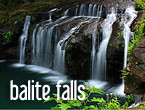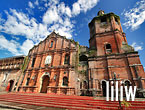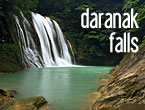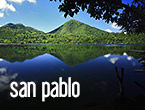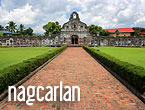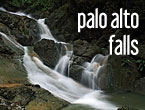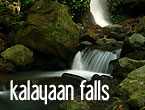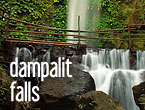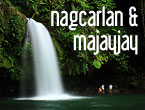Laguna
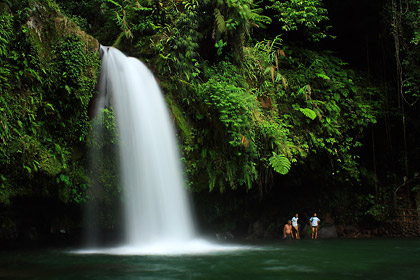
(Laguna) Nang ito ay marating ko
(Laguna) Para bang ako ay nagbago
(Laguna) Kakaibang damdamin
– Sampaguita (written by Gary Perez)
It's not surprising that Pinoy rock queen Sampaguita would croon over this province. With its picturesque waterfalls, hot and cold springs, attractive churches and scenic lakes, Laguna is an indubitable plethora of natural, cultural and historical gems. And with its proximity to Metro Manila, the province is a no-brainer whenever we want a quick and easy getaway from the confines of our concrete jungle.
The Southern Shores of Laguna de Bay
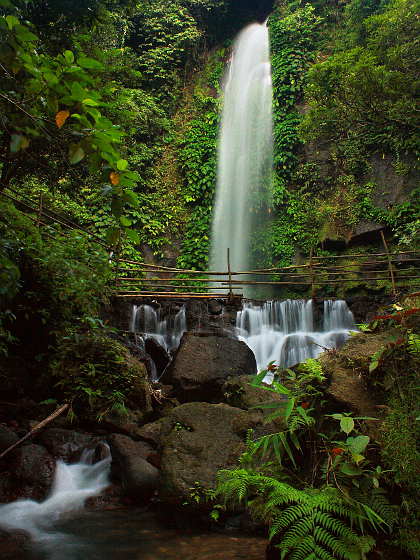
Los Baños' surprise: Dampalit Falls
Although most of the western Laguna towns nearest to Metro Manila have been undergoing rapid urbanization, there are still many locations in the province that have remained relatively unspoiled. Los Baños, known for its various springs along with nearby Calamba, has become more crowded in recent years. However there are still pockets of well-preserved forests accessible through the University of the Philippines Los Baños and the Makiling Rainforest Park at the slopes of Mount Makiling. Two years ago we were also surprised to discover that there is a waterfall in the town, tucked away inside a forest at the Mt. Makiling Nature Reserve: Dampalit Falls.
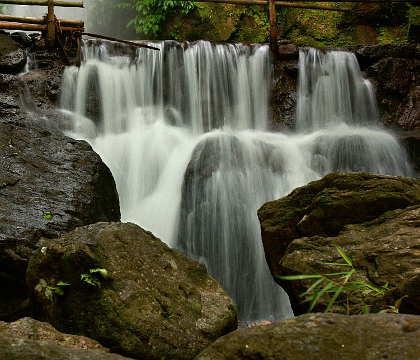
Smaller cascades at the foot of Dampalit Falls
Los Baños and the towns along the southern shores of Laguna de Bay are the more famous tourist destinations. Probably the most iconic tourist destination in Laguna is the Pagsanjan Falls and the accompanying boat ride along the Bumbung River where tourists can "shoot the rapids" while enjoying the sight of the verdant, forest-clad canyon along the banks of the river. Incidentally, the "Pagsanjan Falls" is actually the Magdapio Falls (its indigenous name) and the falls itself is located in the nearby town of Cavinti. Leo had a not-so-pleasant experience with the boatmen during his first and only trip to the falls in the early '90s but we've learned that the local tourism folks have taken steps to address this problem. There is now an alternative route to the falls - through the Pueblo El Salvador Nature Park and Picnic Grove in Cavinti.
If you're after old houses and the like, head up to Pila just before Santa Cruz from Los Baños. The town prides itself with its collection of Spanish-era and early 20th century houses. Pila was declared by the National Historical Institute as a national historical landmark.
The Towns at the Foot of Mount Banahaw
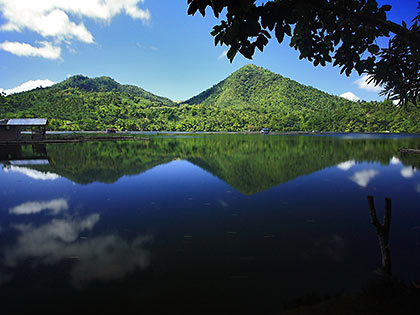
Lake Mohikap, one of San Pablo's Seven Lakes
Moving southwards away from the lake and towards the provinces of Batangas and Quezon, the scenery changes from lowland lakeshore towns to the wooded and hilly municipalities at the foot of Mounts Banahaw and San Cristobal. San Pablo City, one of the oldest in the country, is a jump-off point for trekkers doing Mt. Banahaw. This city is also famous for its Seven Lakes, namely Lakes Sampaloc, Pandin, Yambo, Bunot, Calibato, Mohikap and Palakpakin. Visiting all seven lakes has been on our sights for some time now but we've only been able to visit 5.
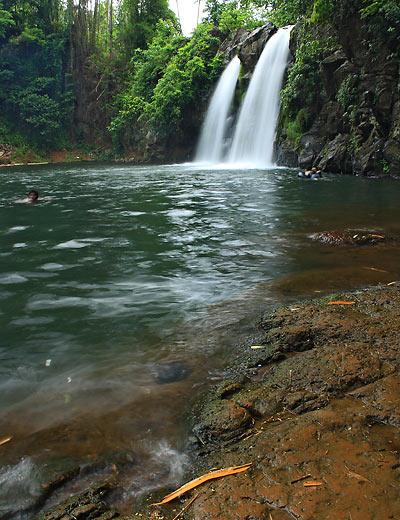
Bunga Falls, Nagcarlan
Along the national road to Lucban, Quezon from San Pablo is the town of Nagcarlan. A large municipality in terms of land area, this upland town includes large portions of the Mt. Banahaw-Mt. San Cristobal Protected Landscape. Mountaineers have been using the town as a jump-off point to several peaks in the area. Many mountain springs find their way into town, providing convenient locations for many spring resorts. But the most attractive destinations in town for us are Bunga Falls and the Nagcarlan Underground Cemetery. Bunga Falls is a twin-waterfall located about 4 kilometers from the town center. The Nagcarlan Underground Cemetery, a historic spot, is located along the national road just 2 kilometers away from the town center.

Slippers and a red church: among the colorful attractions in Liliw
Continuing along the road to Lucban, the next town after Nagcarlan is Liliw, a charming little town with several attractions. Liliw used to be famous for its many cold mountain springs but in recent years it has become known as the Tsinelas Capital of the country for its footwear industry. Looking for cheap but attractive and well-made slippers and other footwear? This town has more than 80 shops that offer them. You can also take a break from shopping and visit the beautiful red brick San Juan Bautista Church nearby or the many old houses along Gat Tayaw and nearby streets. You can also enjoy good food at two dining establishments here: Chef Mau Restaurant and Arabela Italian Restaurant.
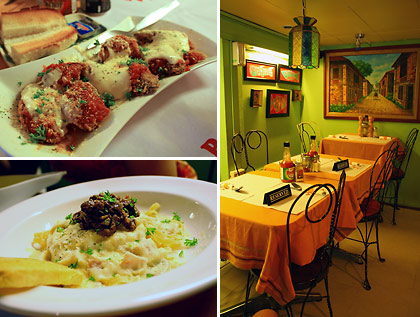
Inside Arabela Italian Restaurant, Liliw
The last town on this side of Laguna before crossing over to Lucban is Majayjay. The most famous tourist destination here is Taytay Falls, a favorite of local picnickers. Like Liliw and Nagcarlan this town has its own share of spring resorts (both cold and warm). Remember to also check out St. Gregory's Church at Majayjay's town center.
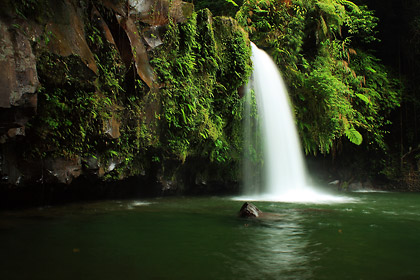
Taytay Falls, Majayjay
One previously almost unheard-of town that is fast becoming popular nowadays is Luisiana, a town on the road from Lucban to Pagsanjan. We've known for a while that this sleepy town is home to at least a dozen major waterfalls, almost all of which are hard to access. Lately however, folks in town have been improving access to these falls including providing local guides for tourists. Among the more visited falls are Aliw, Talay and Hulugan Falls. All falls are impressive-looking especially Hulugan Falls.
The Northeastern Towns
Sandwiched between the shores of Laguna de Bay and the Sierra Madre range in Quezon, these Laguna towns are home to relatively pristine natural attractions. Because of its topography, the northeastern towns boast of numerous waterfalls and other nature destinations. While the towns south of the lake may be accessed via the South Luzon Expressway (SLEX), we often reach the northeastern towns via the Manila East Road along the northern shores of the lake or lately through the Marilaque (Manila-Rizal-Laguna-Quezon) Highway or Marikina-Infanta Highway from Marikina town.
The town of Lumban, northeast of Pagsanjan town, is famous for its centuries-old, superior hand-embroidery. Fashion designers and celebrities go all the way to this town to get intricately embroidered jusi or piña fabrics for barong Tagalogs and gowns. Lumban is also the site of Caliraya Dam and the lake it created – namely Caliraya Lake. This lake has become a popular spot for watersports including angling and many other outdoor recreational activities. We must have stayed at a resort here a dozen times for conferences, trainings and retreats but never had the pictures to show for.
North of Lumban is the town of Kalayaan, home of the Kalayaan Twin Falls. We actually counted 6 waterfalls in the resort that encompasses the falls, so how it came to be called twin falls is still a puzzle to us. On a visit to this town we had a chance to drop by and sample fare at the Exotik Restaurant. The name of the restaurant itself will already give you a good idea of the kind of fare they offer although they do have more mundane "traditional" dishes for the faint of culinary heart.
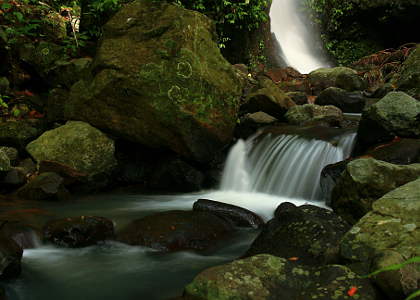
Kalayaan Twin Falls in the background
Handicrafts abound in this province and Paete, the next town on our list, is another example of that fact. Known for woodcarving and papier mache art, Paete has actually widely exported its craft; its woodcarvings are known worldwide and after a visit to some of their shops it was not hard for us to see why. The Saint James the Apostle Parish church, the Tatlong Krus (Three Crosses) on a hill overlooking Laguna de Bay and Matabungka Falls nearby are among the spots in town that you can visit.
Further up north, it's waterfalls galore in the quiet towns of Pangil, Mabitac/Santa Maria, Famy and Siniloan. Pangil has the aptly named Buntot Palos Falls while Mabitac/Santa Maria has its Three Falls. Mt. Romelo in Siniloan has at least four that are accessible: Buruwisan Falls, Lanzones Falls, Batya-batya Falls and Sampaloc Falls. It will take at least 2 hours of hiking to reach Buruwisan, the most accessible falls in Mt. Romelo but the mountain trek is supposed to be relatively easy and one for mountain-climbing beginners.


